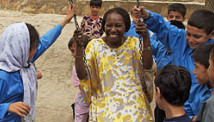STORY HIGHLIGHTS
- NEW: Los Angeles Police still guard some people named in Christopher Dorner's manifesto
- NEW: But the LAPD returns to normal operations the day after a mountain standoff
- Authorities have not conclusively identified a body as that of Dorner
- The body was discovered in the ashes of a cabin where he was believed to be
Follow the story here and at CNN affiliates KCBS/KCAL, KABC, and KTLA.
Near Big Bear Lake, California (CNN) -- Los Angeles police kept watch over some of their own again Wednesday, not ready to let down their guard until investigators can say for sure that the charred human remains found inside a burned mountain cabin are those of Christopher Dorner.
Authorities say it may take days before they can say if the body found inside the cabin was Dorner's, the onetime police officer suspected in four killings during a self-proclaimed guerrilla war on his former compatriots.
While officials were reluctant to say they were certain they had ended Dorner's vendetta, the frenzied manhunt, roadblock and helicopter flights that had preceded the standoff died down Tuesday night.
Los Angeles police also returned to normal patrol operations after days of heightened alert, Lt. Andy Neiman said Wednesday.
But police continued to protect some of the dozens of police officers and their relatives threatened by Dorner in a manifesto vowing revenge over his firing from the Los Angeles Police Department several years ago.
"There's great fear there," Neiman said.
Los Angeles Mayor Antonio Villaraigosa said that while Dorner's body has not been conclusively identified, "I can tell you that there is a sigh of relief among the vast majority of these officers."
Timeline in manhunt
Standoff
Tuesday's events came five days after authorities found Dorner's burned truck on a forest road near the lake, which is about 100 miles east of Los Angeles. Officers converged on the remote area but the trail went cold for days. On Sunday, the San Bernardino authorities said they had scaled back the search.
Los Angeles authorities had issued a $1 million reward for Dorner's capture. Villaraigosa said it was too soon to say if anyone would be able to claim the reward.
What may have been the final act in the Dorner saga began Tuesday, when California Fish and Wildlife wardens said they spotted Dorner driving a purple Nissan down icy roads near Big Bear Lake. He was driving very close to some school buses as if using them as cover, said Lt. Patrick Foy.
No children were on the buses, Foy said.
The wardens, driving in two different vehicles, chased Dorner. A gun battle ensued.
One of the warden's cars was hit, Dorner crashed his car and ran, according to authorities. He then carjacked a pickup truck.
Rick Heltebrake, a camp ranger, said he was driving when he saw the crashed purple truck -- and then something terrifying.
"Here comes this guy with a big gun and I knew who it was right away," Heltebrake told CNN affiliate KTLA. "He just came out of the snow at me with his gun at my head. He said, 'I don't want to hurt you. Just get out of the car and start walking.'"
Heltebrake said the man let him take his dog and walk away with his hands up.
"Not more than 10 seconds later, I heard a loud round of gunfire," Heltebrake said. "Ten to 20 rounds maybe. I found out later what that was all about."
The fire
Dorner fled to a nearby cabin and got into another shootout with San Bernardino County deputies, killing one and wounding another.
San Bernardino County Sheriff John McMahon told reporters Tuesday the other deputy was in surgery "but he should be fine."
Some of the firefight between police and the suspect was captured live on the telephone of a reporter for CNN affiliates KCBS and KCAL. Police in Los Angeles listened live over police scanners broadcast on the Internet, Neiman said.
"It was horrifying to listen to that firefight," he told reporters.
The cabin caught fire when police tossed smoke devices inside, a law enforcement source told CNN.
The intense fire burned for hours as authorities waited at a distance.
After initially saying no body had been found, sheriff's investigators finally confirmed overnight that they had found charred human remains within the ashes.
The department said it will work to identify the remains -- but it could take a while.
Devices such as flash bang grenades and tear gas canisters designed to disorient and disable suspects can cause fires, CNN contributor Tom Fuentes, a former FBI assistant director, said Wednesday.
Death toll
The deputy's death in the shootout Tuesday brought to four the number of people police believe Dorner killed.
Dorner, a man who vowed to kill police officers to avenge what he called an unfair termination, was first named a suspect in two shooting deaths on February 3: Monica Quan, the daughter of his police union representative and her fiance, Keith Lawrence.
Police also say he killed Riverside, California, police Officer Michael Crain and wounded Crain's partner in an ambush on their patrol car Thursday. Police say he also wounded an LAPD officer who chased him in the suburban city of Corona, California.
Manifesto
Police say Dorner a promised war on police after issuing a manifesto blaming the LAPD for mistreating him. He claimed he was railroaded out of the department after filing a brutality report against another officer and said a culture of racism and misconduct continues within the department.
The manifesto warned dozens of LAPD figures and their families that he would wage "asymmetric warfare" against the department, drawing on his training with the LAPD and as a Naval officer in river warfare and security units.
He said it was not something he enjoyed, but called it a "last resort" to clear his name and bring change to the department.
He also predicted his own death would come in a confrontation with police.
"Self Preservation is no longer important to me," the manifesto said at one point. "I do not fear death as I died long ago."
CNN's Miguel Marquez reported from near Big Bear Lake and Lateef Mungin wrote from Atlanta. CNN's Paul Vercammen, Stan Wilson, Casey Wian, Kathleen Johnston, Alan Duke, Matt Smith, Chelsea J. Carter, Michael Martinez, Holly Yan and Michael Pearson also contributed to this report.













